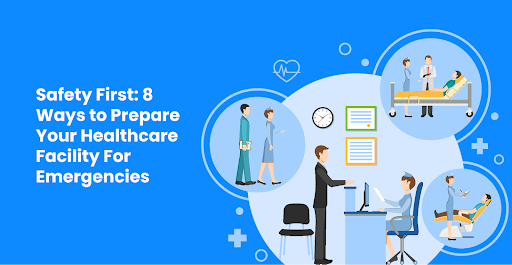In the world of healthcare, where every moment counts, the stakes couldn’t be higher. This is why most healthcare facilities already have existing emergency precautionary measures in place.
However, despite existing measures, there are gaps and challenges in emergency preparedness.
The good news is we are here to help you through it.
In this article, you’ll learn to assess risks and communicate faster and better with your team. You’ll also discover how to coordinate with other agencies.
After reading this article, you’ll master how to make your healthcare facility more resilient and ready for any challenge.
Let’s dive in.
| SMSCountry is the best bulk SMS service to delight your patients. Learn more about our SMS services. Get started or schedule a demo. |
What emergencies do healthcare facilities face?
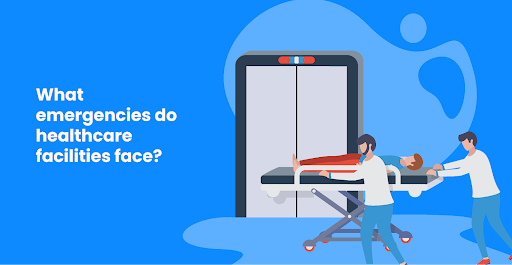
Imagine having a busy day at your healthcare facility. You’re caring for your patients, managing your staff, and overseeing the operations.
Suddenly, the power goes out. The lights, computers, medical equipment, everything stops working.
You have patients who need urgent care. And your staff are confused and panicking. No one knows how long the outage will last.
What do you do? This is not a hypothetical scenario. It could happen at any time.
Your healthcare facility could also face these emergencies:
- Natural disasters: Earthquakes, floods, hurricanes, and wildfires.
- Medical crises: Pandemics, infectious disease outbreaks, and large-scale accidents.
- Technological failures: Power outages, IT system crashes, and equipment malfunctions.
- Security threats: Acts of violence, intrusions, and cybersecurity breaches.
- Supply chain disruptions: Shortages of critical medications, equipment, or personnel.
- Patient surge: Unprecedented patient influxes, overwhelming resources.
- Utility Failures: Water supply disruptions, gas leaks, and heating/cooling system failures.
- Environmental hazards: Chemical spills, radiological incidents, and air quality concerns.
- Personnel shortages: Staffing crises due to illness, injury, or other factors.
- Communication breakdowns: Information flow disruptions during emergencies.
These emergencies range from natural to man-made disasters.
Yet it doesn’t matter what type of emergency you face. You must prepare to protect your patients, staff, and facility.
Why is emergency preparedness important in your healthcare facility?
Emergency preparedness is not just a buzzword. It’s vital in running a successful and reputable healthcare facility.
Here are six reasons why:
- Lives are at stake: This is the most prominent and essential reason. It prevents further harm to patients’ lives.
- Reputation: A negative image can damage your credibility. On the other hand, a prepared healthcare facility demonstrates its competence. It earns the respect and loyalty of its stakeholders.
- Costs: Emergencies can be costly. Preparing for emergencies reduces the losses and damages that may occur. It also saves you from legal liabilities and penalties arising from negligence or non-compliance.
- Efficiency: Emergencies can disrupt normal operations and cause delays and errors. But when you are prepared for emergencies, you can maintain your productivity and quality of service.
- Trust: It fosters trust within the community. Patients and their families rely on healthcare facilities to provide safe, secure environments. You don’t want to disappoint them.
- Staff safety: Preparedness measures safeguard the well-being of healthcare workers, encouraging their dedication to the profession.
So don’t wait for an emergency to occur. Be ready for it (and we’ll show you how).
How to prepare your healthcare facility for emergencies
Here are 8 ways to fortify your healthcare facility against emergencies.
#1. Develop an emergency response plan
A clear plan is key to successful follow-up. Do the following:
- Establish an interdisciplinary emergency response team: Assemble a dedicated team with diverse skills and expertise. Include clinicians, administrators, security personnel, and IT experts, among others.
- Prepare a risk assessment to identify potential emergencies: No two healthcare facilities are alike. And, neither are their potential emergencies. So, identify the unique challenges your facility may face. Explore factors such as location, climate, and the nature of your services.
- Create a comprehensive emergency response plan: Clearly state the roles and obligations of each team member. Ensure that every staff member knows their role in an emergency. Also, ensure there are backup personnel trained to step in when necessary.
#2. Ensure adequate staff training
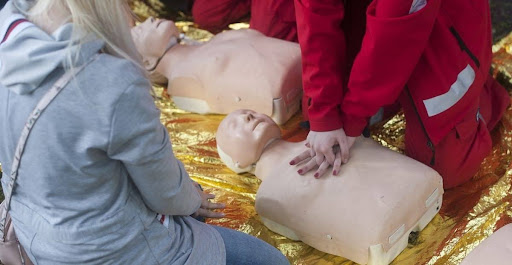
Practice, practice, practice. It cannot be overemphasised.
Practising ahead of emergencies makes it easier when trouble strikes. Here’s how:
- Provide Basic Life Support (BLS) and Advanced Life Support (ALS) training: Human lives hang in the balance during emergencies. So, ensure your staff is well-versed in Basic Life Support (BLS) and advanced life support (ALS) techniques. This includes Cardiopulmonary Resuscitation (CPR) and other life-saving skills.
- Conduct regular drills and simulations for emergency scenarios: Practice makes perfect. And this rings true in emergency preparedness. Run regular drills and simulations to teach staff the procedures to follow in a crisis. These exercises include fire drills, evacuation scenarios, and response to infectious disease outbreaks.
- Training staff on the proper use of emergency equipment and protocols: From oxygen tanks to isolation procedures, thorough training ensures a swift and coordinated response.
#3. Maintain essential infrastructure and resources
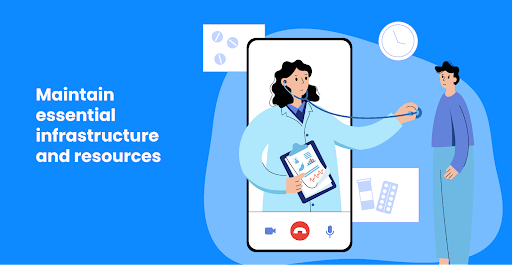
Without adequate infrastructure, handling emergencies will only get more challenging.
So, here’s what to do before an emergency occurs:
- Ensure backup power supply systems: Invest in backup power supply systems. They guarantee that critical equipment remains operational during power outages.
- Stock sufficient medical supplies: Supplies like medications and personal protective equipment (PPE) are important. In emergencies, the demand for these supplies can skyrocket. Ensure your facility is well-stocked to meet these surges in demand.
- Implement a reliable communication system: During chaos, communication is the most vital. Set up a robust communication system via SMS. It’s cost-effective and the most reliable during an emergency. When traditional channels are disrupted, SMS ensures that information flows smoothly.
#4. Establish collaborative relationships
Teamwork is key to effective communication during emergencies.
Here’s how to work with others to tackle an emergency:
- Collaborate with emergency management agencies: Your local emergency management agencies are your team of local heroes. And they’re your lifeline in times of trouble.
- Develop partnerships with neighbouring healthcare facilities: In such times of crisis, they can be your greatest allies. Forge partnerships for mutual aid. Share resources, personnel, and support, reinforcing each other’s capabilities.
- Participate in emergency preparedness exercises: Participate in community-wide emergency preparedness exercises and initiatives. This fosters a sense of unity. It also ensures a synchronised approach to disaster response.
#5. Implement robust information management systems
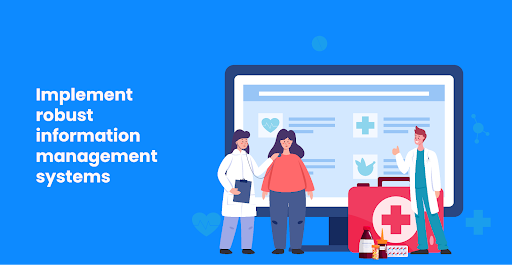
You’ll also need a reliable communication system. It must be secure, compliant, and practical at the same time.
Here’s what we recommend:
- Establish secure data backup and recovery processes: In the digital age, safeguarding data is as critical as any other aspect of preparedness. Implement secure data backup and recovery processes to protect critical patient information and healthcare records from loss or corruption.
- Ensure protected electronic health records (EHRs) and patient information: Patients trust your facility with their most sensitive information. Ensure that electronic health records (EHRs) and patient data are safeguarded from breaches and kept confidential.
- Implement a communication system for disseminating emergency information: Clear and timely communication enhances calm and chaos during an emergency. SMS is reliable, with an open rate of 98%. With SMS, vital information reaches staff, patients, and their families efficiently.
| See the top bulk SMS service providers to send transactional and promotional SMS. Check out the top OTP service providers to send fast and secure OTPs. |
#6. Conduct regular drills and exercises
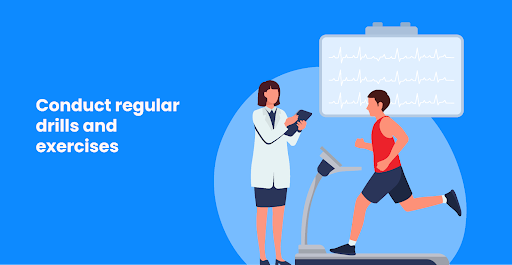
When you’re prepared, handling emergencies becomes easier. Hence, there is a need for frequent drills and exercises.
Do these:
- Perform emergency response drills: Regular assessment of your facility’s emergency preparedness is vital. This proactive approach ensures continuous readiness.
- Conduct tabletop exercises: Tabletop exercises offer a chance to simulate emergency scenarios without the physical demands of full-scale drills. These exercises allow staff to test response capabilities, refine coordination, and familiarise themselves with protocols.
- Analyse drill outcomes: The learning from drills is invaluable. After each drill, analyse the outcomes rigorously. Use these insights to update and fine-tune your emergency response plan.
#7. Prioritise psychological and emotional support
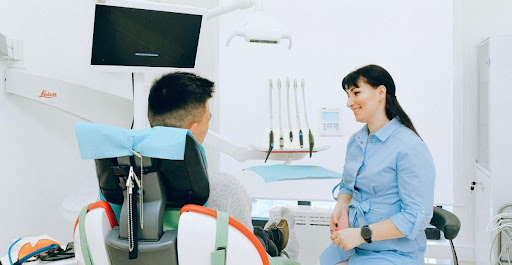
Most emergencies leave scars. These scars come in the form of emotional and physical trauma.
So, follow these support tips before emergencies:
- Develop a plan: Emotions run high during emergencies. Develop a comprehensive plan to address the mental health needs of not only patients but also your dedicated staff and volunteers. Recognising and supporting their emotional well-being is a crucial facet of emergency preparedness.
- Provide resources: Offer resources and counselling services that provide emotional support to those affected by emergencies. This can include counselling for patients, staff, and volunteers, ensuring that they have a safe space to process their emotions and experiences.
- Train staff: Equip your staff with the tools to provide psychological first aid and manage stress. These techniques enable them to offer immediate support and comfort to distressed individuals while safeguarding their mental health.
#8. Review and update the emergency plan
Every day, new situations arise.
Consequently, yesterday’s solution may not be enough for today’s emergency.
Here’s how to update your emergency plan:
- Conduct regular reviews and revisions: An emergency response plan is a living document. Regularly review and revise it to adapt to changing circumstances and evolving best practices. This proactive approach keeps your facility’s preparedness sharp and effective.
- Incorporate lessons from emergencies: Real emergencies and drills offer invaluable lessons. Incorporate these insights into your emergency response plan. This will enhance its responsiveness and adaptability.
- Stay updated on evolving best practices: The world of emergency preparedness is ever-evolving. Stay updated on the current best practices and regulatory requirements. It keeps your facility compliant and ready for any scenario.
There you have it: 8 key ways to prepare for emergencies in your healthcare facility.
Need help at any stage? Consult with our experts. We can help you implement SMS effectively in every stage of your emergency plan.
Using SMS for effective communication during emergencies
In the chaos of emergencies, swift and reliable communication is necessary.
Short Message Service (SMS) is the most effective communication tool during emergencies. Here’s why:
- SMS has instant delivery: SMS messages reach recipients almost instantly, ensuring rapid dissemination of critical information.
- SMS has a high open rate of 98%: People are more likely to read SMS messages promptly. This makes it an ideal medium during emergencies.
- SMS has wide accessibility: It’s accessible to most of the population. This makes it an inclusive communication tool for all.
- SMS has uninterrupted service: It remains operational even when other forms of communication may fail.
During emergencies, communication problems skyrocket. Only SMS can boost your chances of success.
We strongly encourage you to integrate SMS into your emergency strategy.
Your ultimate healthcare emergency checklist
You want to be ready for anything at your healthcare place. Hence, the World Health Organisation has provided a comprehensive emergency checklist.
Here are critical points in the checklist:
- Ensure you set up an innovative plan.
- Educate your staff on how to do BLS, ALS, and emergency things.
- Keep your vital infrastructure working, like backup power supply systems.
- Work with local groups and other healthcare places.
- Use safe systems and ways to talk and share information.
- Conduct regular drills and exercises to evaluate preparedness.
- Provide psychological and emotional support for patients, staff, and volunteers. Help people feel better when they are scared or sad.
- Review and update your emergency plan often, and learn from mistakes.
- Use SMSCountry to communicate better and faster via SMS.
This checklist is your compass in the face of uncertainty. However, we won’t leave you to face it all alone.
SMSCountry makes your healthcare facility before and during emergencies
You’ve learned 8 proven ways to prepare your healthcare facility for emergencies. But there’s one more thing you need to do.
You need SMS in your emergency strategy. Why?
Because SMS is the most reliable, cost-effective, and easy-to-use communication channel for emergencies, and SMSCountry is the best SMS provider for you.
With SMSCountry, you’ll enjoy:
- High-quality service and delivery.
- Affordable and flexible pricing plans.
- Easy-to-use interface and APIs.
- 24/7 customer support and assistance.
Sign up for free today, or request a demo and see for yourself.
Let’s help you prepare for, prevent, and tackle emergencies in your healthcare facility.
FAQs
What is hospital emergency preparedness?
Hospital emergency preparedness is the process of planning and preparing for different types of emergencies that could implicate the health and safety of patients, staff, and facilities. It involves developing a comprehensive emergency response plan, ensuring adequate staff training, maintaining essential infrastructure and resources, and establishing collaborative relationships with other agencies and organisations.
Why is hospital emergency preparedness important?
Hospital emergency preparedness helps save lives, reduce injuries, and minimise damages during emergencies. It can also help ensure the continuity of care and services, protect the reputation and credibility of the facility, and comply with the regulatory requirements.
What are some examples of emergencies that could affect healthcare facilities?
Some examples of emergencies that could affect healthcare facilities are:
- Natural disasters like earthquakes, floods, hurricanes, and wildfires.
- Medical crises like pandemics, infectious disease outbreaks, and large-scale accidents.
- Technological failures like power outages, IT system crashes, and equipment malfunctions.
- Security threats such as acts of violence, intrusions, and cybersecurity breaches.
- Supply chain disruptions like shortages of critical medications, equipment, or personnel.
- Patient surges like unprecedented patient influxes, which ends up overwhelming resources.
- Utility failures like water supply disruptions, gas leaks, and heating/cooling system failures.
- Environmental hazards like chemical spills, radiological incidents, and air quality concerns.
How can healthcare facilities prepare for emergencies?
Healthcare facilities can prepare for emergencies by following these steps:
- Develop an emergency response plan that covers the roles and obligations of each team member, the procedures to follow in different scenarios, and the resources and equipment needed.
- Ensure adequate staff training on Basic Life Support (BLS) and Advanced Life Support (ALS) techniques, emergency equipment and protocols, and drills and simulations.
- Maintain essential infrastructure and resources such as backup power supply systems, medical supplies, medications, personal protective equipment (PPE), and communication systems.
- Establish collaborative relationships with local emergency management agencies, first responders, neighbouring healthcare facilities, and community organisations.
What are the benefits of using SMS in the emergency communication strategy?
Here are some benefits of using SMS during emergencies:
- SMS is reliable and cost-effective
- It’s quick and easy to use during emergencies
- You can use SMS to coordinate with team members and other agencies
- SMS lets you send and receive critical information and updates unobstructed. It provides guidance and support to staff and patients.


